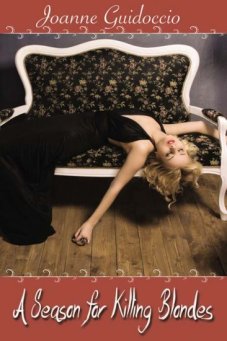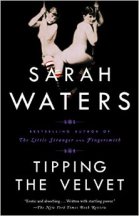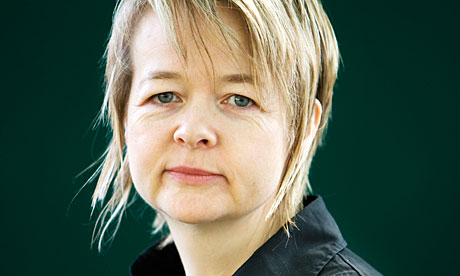 Guelph author Joanne Guidoccio’s newest novel, A Season for Killing Blondes, has everything a mystery lover could want: a heroine in distress, an old flame from her past, vexing villains and, of course, a series of gristly murders.
Guelph author Joanne Guidoccio’s newest novel, A Season for Killing Blondes, has everything a mystery lover could want: a heroine in distress, an old flame from her past, vexing villains and, of course, a series of gristly murders.
The books is lighter in tone but for me avoided the cutesy feel of the cozy subgenre. Our main character Gilda Greco is embarking on a new phase of her life with a new counseling practice, but hours before her first client arrives she discovers a dead body!
I had the opportunity to interview Joanne about her writing after a workshop she presented on mystery writing at the Guelph Public Library alongside three other local authors.
GPL: Your first book Between Land and Sea is quite original. What inspired you to write about a mermaid? What was the response to the story from your readers?
 JG: On a whim, I took a series of workshops offered by dark fantasy and horror writer Sarah Totton and toyed with the idea of writing fantasy for boomer women. Not wanting to feature witches, werewolves, zombies or other dark creatures, I thought back to my childhood and recalled my favourite fairy tale, The Little Mermaid. I began by asking myself a series of “what ifs.” What if the mermaid wasn’t so young or so beautiful? What if the man abandoned her? What if she had to reinvent herself? Then I put pen to paper and wrote the first draft. I was very pleased with the response from Canadian, American, and British readers. One of my favourite reviews comes from Colleen McConnell: “The novel is a classic wisdom tale with a twist and is reminiscent of Jane Austen.”
JG: On a whim, I took a series of workshops offered by dark fantasy and horror writer Sarah Totton and toyed with the idea of writing fantasy for boomer women. Not wanting to feature witches, werewolves, zombies or other dark creatures, I thought back to my childhood and recalled my favourite fairy tale, The Little Mermaid. I began by asking myself a series of “what ifs.” What if the mermaid wasn’t so young or so beautiful? What if the man abandoned her? What if she had to reinvent herself? Then I put pen to paper and wrote the first draft. I was very pleased with the response from Canadian, American, and British readers. One of my favourite reviews comes from Colleen McConnell: “The novel is a classic wisdom tale with a twist and is reminiscent of Jane Austen.”
GPL: I was pleasantly surprised to discover that the Guelph Public Library was a part of your publishing history. What was it like working on the local Memoirs project with other members of the community?
JG: I was inspired by co-facilitators Karen Cafarella and Deb Quaile and the other six participants in the project. We met for eight Wednesday afternoons over a four month period and shared our experiences from locations all over the world, including China, England, Lebanon, Brazil, Northern Ontario, and the former Yugoslavia.
GPL: What would you say to someone who struggles to find the time to write?
JG: While teaching, I struggled to find time each day to write. In retirement, I have more flexible time but still need to follow a daily regimen. I would advise aspiring writers to carve out an hour each day for planning and writing. If you’re wondering where to find the time, cut back on activities such as television viewing and social media.
 GPL: Working with small publishing presses these days can be tricky. What has been your experience with them? Do you have any thoughts on self-publishing?
GPL: Working with small publishing presses these days can be tricky. What has been your experience with them? Do you have any thoughts on self-publishing?
JG: From the start, I wanted to be traditionally published. I feel more comfortable knowing that experienced professionals will select the best cover and ensure that editing and formatting are properly done. While I admire and respect writers who choose to self-publish, I have neither the time nor inclination to mount that steep learning curve.
GPL: Who were some of your favourite authors growing up and who do you find yourself reading now? What draws you to these writers? Do you have a specific book that you’re dying to recommend?
JG: I have eclectic tastes and enjoy reading contemporary women’s fiction, cozy mysteries, thrillers, historical fiction, self-help, and memoirs. While the storylines vary, reinvention is a common theme throughout many of the books I read. Also, the protagonists are usually boomer women. In short, I enjoy reading and writing boomer lit. I highly recommend The Japanese Lover by best-selling author Isabel Allende. This well-crafted love story set against the backdrops of Poland and San Francisco sweeps from World War II to the present day.
GPL: Tell me about your contribution to We’d Rather Be Writing: 88 Authors Share Timesaving Dinner Recipes and Other Tips. And what is No Kid Hungry?
JG: I was very excited when USA Today Bestselling Author Lois Winston invited me to be part of this extraordinary venture. I contributed a recipe–Quick ‘n’ Easy Halibut–and a time-saving tip. A portion of proceeds will be given to No Kid Hungry. Millions of kids in America face the school day on an empty stomach because there isn’t enough food at home. But hungry kids can’t learn. No Kid Hungry adds one million kids to the school breakfast program.
Joanne’s blog is entitled “On The Road to Reinvention” and can be followed at joanneguidoccio.com.



 Jonathan Kemp’s
Jonathan Kemp’s 


 The latest book for our LGBTQ Book Club to review is Sarah Waters’
The latest book for our LGBTQ Book Club to review is Sarah Waters’ 
 I was also pleasantly surprised at how much I identified with Nan, particularly when she first begins to explore her sexuality. In my youth, I can remember being fascinated by a soap opera actor in the same way Nan was fascinated by Kitty. I found myself talking about him all the time and wanting my family to see him on television. I could understand why Nan was so excited when her family wanted to see Kitty’s act for the first time. When I shared this memory with the group I was delighted to discover that most of them could remember a similar experience of infatuation in their youth. After much prodding they even got me to name the aforementioned soap opera actor. Here, however, he shall remain anonymous. Sorry.
I was also pleasantly surprised at how much I identified with Nan, particularly when she first begins to explore her sexuality. In my youth, I can remember being fascinated by a soap opera actor in the same way Nan was fascinated by Kitty. I found myself talking about him all the time and wanting my family to see him on television. I could understand why Nan was so excited when her family wanted to see Kitty’s act for the first time. When I shared this memory with the group I was delighted to discover that most of them could remember a similar experience of infatuation in their youth. After much prodding they even got me to name the aforementioned soap opera actor. Here, however, he shall remain anonymous. Sorry.

 As a parent, the book made me question what I am teaching and promoting to my own children. Am I really wrong to encourage resume virtues and to praise their accomplishments?
As a parent, the book made me question what I am teaching and promoting to my own children. Am I really wrong to encourage resume virtues and to praise their accomplishments?











 When I first saw
When I first saw